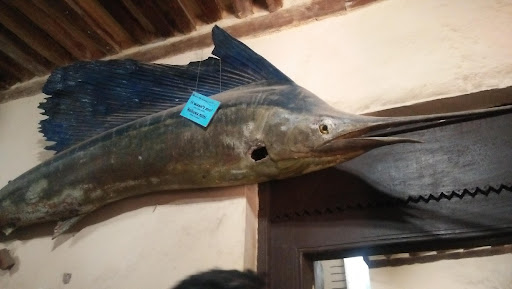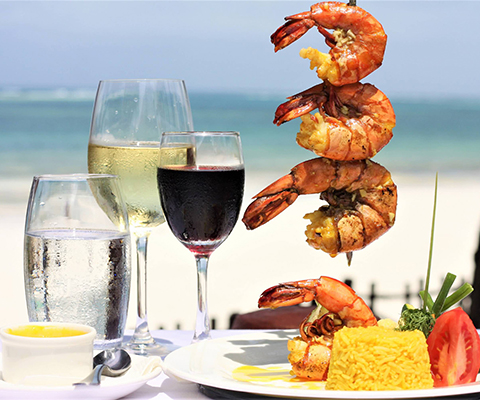The House of Columns is a museum-like building located in Malindi. It has numerous marble pillars on its front side and is a three-story building hence the name, House of Columns.
The historic site is one of the oldest buildings in Malindi and is said to have been a hospital in the past. But now, it holds marine exhibitions, including one of the most remarkable marines of all time – the strange catch.
Also read Fun places to visit in Malindi.
House of Column Entry Charges
To access the House of Column, you’ll have to pay a fee as follows:
Non-residents
Adults: 500
Children: 250
East African
Adults: 400
Children: 200
Citizen
Adults: 100
Children: 50
Please note that these charges include visiting other destinations within the circuit. This means that once you pay the fee, you can use your ticket to access other attractions including:
- The Vasco Da Gama Pillar
- The Sea Farers Monument
- The National Museums of Kenya, Malindi Museum
- The church
A Brief History of the House of Columns
Records indicate that the house was used in the 19th century by Adulhusein Gulamhusein & Co. But pictures of the structure were featured in an 1898 book showing that it may date from earlier times. In the book, W.W Fitzgerald noted that he arrived in Melindi on 15th July 1891 and stayed with the officer in charge of Melindi District, Mr Bell-Smith. According to the book, his house was a two-storied white building on the beach and was conspicuous from the sea. At the time, Mr Bell-Smith oversaw the construction of Imperial British East Africa Co. offices (Now converted to a museum). Bell-Smith was murdered a few years later and was buried in the graveyard of the nearby Portuguese Chapel (now a National Monument).
The historic building is also said to be the first native hospital for residents. Older residents remember having operations or receiving treatment in a small room on the first floor. But the building later became the first Fisheries office for Malindi. Tom Altree, in his manuscript autobiography, suggests that he bought the building from the Bohra community for 2000 pounds. The Fisheries Department later moved out of the building to offices further south along the beach.
Subsequently, the building housed the Game Department, which became the Wildlife Conservation and Management Department. It then became Kenya Wildlife Service which saw all the KWS Offices located at the Malindi Marine Park at Casuarina Point. Range Management/Livestock Development officers occupied the ground floor of the increasingly dilapidated building until 1999 when it was agreed that the building should be handed over to the National Museums of Kenya (NMK). National Museums of Kenya took over the building in the same year, and in 2002, a salvage operation was carried out. The building was renamed House of Columns.
Mr Caesar Bita, the first NMK curator, was responsible for placing the House of Column at the center of Malindi’s cultural and historical life. He was succeeded by conservator Mrs Aisha Fadhil and later Senior Curator Mr Ghazzal H. Swaleh. The main exhibit on the ground floor is now the Malindi Coelocanth, with temporary exhibitions in the small rooms above. For many years, The House of Columns has been the backdrop of the highly successful Malindi Cultural Festival, usually held over Easter.
The Strange Catch
Beyond history, the House of Column is a spectacular structure. It is home to one of Kenya’s treasures – the strange creature.
On 26th April 2001, MC Venture II set out on a fishing trip to catch prawns. The ship sailed as usual, but at noon, the fishermen pulled a strange creature. One that had never been seen on the Kenyan coast. The crew of 28 argued over what to do with the catch.

Some contemplated throwing it back into the ocean, fearing it might have been an evil spirit or a bad omen. However, the ship’s captain was intrigued by this strange creature and ordered it to be put in the ship’s cold storage. Two days later, the big boat MV Venture II sailed into kilindini harbor and transferred the fish via a truck to Basta and Sons cold storage facilities in Nyali.
Later on, some fisheries officials took the strange catch to the annual Mombasa agricultural show. As you’d expect, the strange catch was a source of curiosity, and many people flocked to the stand for a glimpse. Even H.E. Daniel Toroitich Arap Moi went to see it and declared it a national treasure. After the show, the fisheries officials took the strange catch to Wananchi marine products cold storage, where it stayed for a month before being taken to labs in Nairobi.
It was discovered that the strange catch was a rare type of fish that had not been seen in this part of the world. The peculiar fish now sits at the House of Column. The House of Column Malindi is home to a myriad of fish exhibitions. What’s fascinating is how each fish in the exhibit bears a tag with the marking; it wasn’t me. Just in case you were about to mistake it for the strange catch. So, you have to keep going until you find the odd fish.
Walking around trying to find the strange fish, you’ll discover other fascinating marine life exhibitions and more exciting information about the mystery fish. You’ll also pass by an enclosed box with two openings where you can dip your hand inside to feel the exhibitions. Is it slimy? Rough? Spikey? Smooth? Big? Or small? There’s only one way to find out – and it’s a little scary and fun at the same time.
Then, eventually, you’ll get to the strange catch, and here is what it looks like. Can you take guess what it is?
Well, now that you know what it is, be sure to note that down on the whiteboard at the end of your tour of the House of Columns, Malindi.










